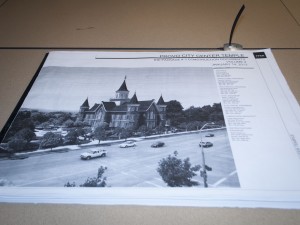In Provo during the late 1940s, Grandma Jones would give a treat to any young boy who helped her carry her groceries the few blocks to her home. Jones’ husband, A. Willis, was the unofficial historian of the city. Their small front room contained bookshelves lined with scrapbooks that contained the town’s past, a town that at that time was one where the income gap was virtually nonexistent. Kids walked to school and the Provo Tabernacle stood as one of the pinnacles of the community.
For a young D. Robert Carter, this was the town he grew up in and the town he still loves. This appreciation for Provo led Carter to follow in Willis’ footsteps, becoming a local historian, gaining a degree in history from BYU and a master’s degree in Western American history. He taught at various junior high and high schools around Utah Valley. After his retirement, Carter wrote a weekly column for the Daily Herald for three years, informing citizens about Provo’s rich history.

“One thing that I really miss is that in those days your barber or the plumber might be your bishop, or in my case, the barber was the stake president and the grocery man was the bishop,” Carter said. “People more on your level were running the church. You felt more close to them because they were more like you.”
To Carter, he said it sometimes feels like he is losing his town, with recent buildings like Nu Skin and the upcoming Convention Center changing the small-town feel it once had.
One of Carter’s favorite memories of the tabernacle was the power he felt just by sitting in the tabernacle, admiring the stained glass windows. For Carter, the view through the west windows could “get you in tune with people from the past.”
Carter said a favorite occurrence happened when he was a small primary child was performing in the tabernacle, something that was saved for special occasions.
“When we performed we felt a sense of accomplishment,” Carter said. “And if you get a sense of accomplishment in a building that gives you a favorable feeling … well, let’s just say, the primary singing far outweighed any enjoyment I got out of stake conference.”
The early, fateful morning in December 2010 when the Provo Tabernacle burned down still weighs on the community, especially to those with lifelong memories of the building. Carter was leaving for a doctor’s appointment when he got a call from a friend, urging him to come to the site.
“I went down and stopped there on the way to the doctor and cried,” Carter said, as he dabbed his eyes. “And then I stopped on the way back from the doctor and cried again. So I watched them fight the fire. And I wondered what would happen to it.”
Carter, along with the rest of the world, learned the tabernacle’s fate during the October 2011 session of General Conference. LDS Church President Thomas S. Monson announced the Provo Tabernacle would be reconstructed into Provo’s second temple.
Life-long Provo residents are not the only ones who have been affected by the presence of the Provo Tabernacle. Elise Osorio, a junior in the Theater Arts Department at BYU, has lived in many places across the country, but admits there is something unique about the iconic Provo site.
Osorio performed with BYU’s Women’s Chorus at the Provo Tabernacle before the fire. She confesses to wanting to get married in the upcoming temple-tabernacle and describes the unique atmosphere there.
“I was most struck by the seating,” Osorio said.”When we performed, it wasn’t like a normal theater where your audience was in one section. It felt like a cathedral.”
BYU graduate Brandon Riggs performed in the Provo Tabernacle 10 times with BYU Men’s Chorus and his folk-music band, “The Lucky Crickets.” Riggs compared the meeting hall to Temple Square in Salt Lake City.
“I didn’t feel devastated because it was a spiritual loss,” Riggs said. “It wasn’t a church, it wasn’t a temple, it was just a meeting hall for whatever you wanted to have there, but a majority of the things that happened there were spiritual in nature.”
The tabernacle served many functions, opening its doors to different community events, not limited to the LDS faith. LeGrand Richards, a BYU professor, has been a stake president in the Provo community for nearly nine years. As the stake president in the region of the Provo Tabernacle, it was Richards’ job to ensure the tabernacle was properly maintained and assigned to the various groups that performed there.
Richards was pleased to learn the tabernacle would be reconstructed into a temple, something he believes was divinely planned and was overwhelmed with the community outreach after the fire. LDS Church members and those with other community affiliations came forward, offering their services to help with reviving the tabernacle to its former glory.
“It’s certainly historically significant for the Church, for the community, for our sense of tying our own experiences to something that was greater and more lasting,” Richards said. “Everything we have is replaceable and temporary, it was nice to have a building with a sense of permanence.”




